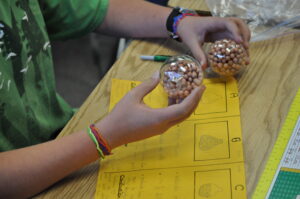Molecular motion

Author(s): Anna-Louise Emrich and Trina Nicklas
Subject: Chemistry
Grade Level(s): Grade 5
Big Idea(s): Atoms move differently in the three different states of matter.
What you need: Three clear containers of the same size and shape, one labeled “A”, one “B” and the last labeled “C”, in any order. Times the number of groups of three in your class. The containers should be filled, or contain small styrofoam beads. Each set should be the same. For example, “A” filled to the top = solid, “B” filled with only a few beads = gas, and “C” about 1/3 filled to simulate liquids. Students will need an activity sheet where the students can compare and contrast with a venn diagram, draw what they see and record attributes of each container. (Trifold)
Ziplock bags to hold the three containers.
Setting: Classroom set up so that students sit in groups of three.
Time Needed: The time needed including instructions, observations, analysis and debriefing would be about 1 hour.
Summary:
Students will compare the characteristics of solids, liquids, and gases at the molecular level and describe the movement of the atoms in each state of matter. They will fill out the observation sheet, drawing conclusions by discussing within their groups and will report back to the class.
Learning Goals / Objectives:
Students will compare and contrast the characteristics of solids, liquids, and gases at the molecular level. They will ultimately be able to describe the movement of the atoms in each state of matter and how that movement affects its characteristics.
Background
Students need to know that all matter is made up of atoms and that there are three states of matter, solids, liquids and gases.
Setup:
Have the forms pre-printed to hand out. Have the three containers labeled, A,B and C and in the Ziplock bags. Students should be grouped in threes and have pencils ready.
Anticipatory Set:
Everything is made up of matter, but the state of that matter differs. (Show a solid. liquid and [air] gas. What do the atoms look like or how do they move within each of these that contributes to their different characteristics? You are going to be the scientist detectives to figure out what each of these unknowns are and why.
Instructions / Activities:
1. Step 1 Info.Teach ground rules and “scientific” behaviors. Explain that each person in the group will be responsible for and the authority of their labeled container. The group, however, will be working together to make their observations,
2. Step 2 Info Hand out one observation sheet to each group.
3. Hand out one Ziplock bag containing the three containers to each group. Then each student in the group picks a container.
4. Let the students have plenty of observation and discussion time.
5. Ultimately each group fills out their venn diagram and paragraph.
Assessment:
Class assessment is made by the observation that each group has correctly identifies the containers correctly and understand the different molecular movement defines the states of matter. Each group will create a three way venn diagram and complete the closure activity or paragraph.
Wrap-up / Closure:
After the students make connections to the samples and the movement of the atoms in each and have drawn their pictures, they fill in a paragraph frame with their observations as a group.
‘CLAIM AND CONCLUSION’
Based on my observations of the three different containers, container “A” is a ________________________, because_________________________________________________________________________.
I believe container “B” is a _______________________________________, because_________________________________________________________________________.
Finally, container “C” is a ________________________________________, because_________________________________________________________________________.
Each of these is a different state of matter.
These “claims are put on the board or wall and reported by the groups. As a class they find the common ideas.
Attachments: Molecular Motion Worksheet

